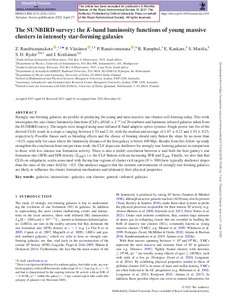The SUNBIRD survey: the K-band luminosity functions of young massive clusters in intensely star-forming galaxies
Ranaivomanana P.; Mattila S.; Kankare E.; Väisänen P.; Ryder S.D.; Ramphul R.; Kotilainen J.; Randriamanakoto Z.
https://urn.fi/URN:NBN:fi-fe2022081154661
Tiivistelmä
Strongly star-forming galaxies are prolific in producing the young and most massive star clusters still forming today. This work investigates the star cluster luminosity functions (CLFs, dN/dL proportional to L-alpha) of 26 starburst and luminous infrared galaxies taken from the SUNBIRD survey. The targets were imaged using near-infrared K-band adaptive optics systems. Single power-law fits of the derived CLFs result in a slope alpha ranging between 1.53 and 2.41, with the median and average of 1.87 +/- 0.23 and 1.93 +/- 0.23, respectively. Possible biases such as blending effects and the choice of binning should only flatten the slope by no more than similar to 0.15, especially for cases where the luminosity distance of the host galaxy is below 100 Mpc. Results from this follow-up study strengthen the conclusion from our previous work: the CLF slopes are shallower for strongly star-forming galaxies in comparison to those with less intense star formation activity. There is also a (mild) correlation between alpha and both the host galaxy's star formation rate (SFR) and SFR density (sigma(SFR)), i.e. the CLF flattens with an increasing SFR and sigma(SFR). Finally, we also find that CLFs on subgalactic scales associated with the nuclear regions of cluster-rich targets (N approximate to 300) have typically shallower slopes than the ones of the outer field by similar to 0.5. Our analyses suggest that the extreme environments of strongly star-forming galaxies are likely to influence the cluster formation mechanisms and ultimately their physical properties.
Kokoelmat
- Rinnakkaistallenteet [19218]
